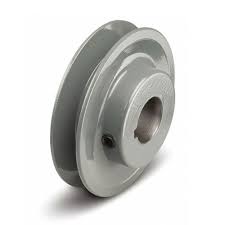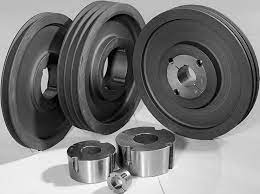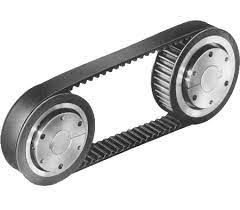Product Description
Customized Heavy Duty Gravity Motor Motorized Roller Head Tail Rubber Lagging Drive Belt Roller Conveyor Drum Pulley Price for Concrete Belt Conveyor
Product Description
The drum is the main component that transmits power. It is divided into 3 types according to their load-carrying capacity: light, medium and heavy.
Light: Bearing aperture 80-100mm, the shaft and hub are single-width plate welded cylinder structure connected by single key.
Medium: Bearing aperture 120-180mm, the shaft and hub are expansion sleeve connection.
Heavy: Bearing aperture 200-220mm, the shaft and hub are expansion sleeve connection, and the drum body is cast-welded structure.
Conveyor pulley stays at 2 ends of belt machine. The pulley can be divided into 2 categories: Driving pulley and averting pulley, driving pulley is the main part for transmitting the power and there are 2 kinds of pulley sets: Smooth surface and rubber surface, and rubber surface can be classified into smooth rubber surface, herringbone rubber surface and CHINAMFG rubber surface to meet different technical requirements. Averting pulley can be classified into smooth rubber surface and smooth steel surface.
Technical Parameters
| Driving Pulley (rubber surface) | |
| Belt Width | Standard Diameter of Pulley |
| 500 mm | 500mm |
| 650 mm | 500mm,630 mm |
| 800 mm | 500mm,630mm,800mm,1000mm,1250mm,1400 mm |
| 1000 mm | 630mm,800mm,1000mm,1250mm,1400 mm |
| 1200 mm | 630mm,800mm,1000mm,1250mm,1400 mm |
| 1400 mm | 630mm,800mm,1000mm,1250mm,1400 mm |
| 1600 mm | 630mm,800mm,1000mm,1250mm,1400 mm |
| 1800 mm | 630mm,800mm,1000mm,1250mm,1400 mm |
| 2000 mm | 800mm,1000mm,1250mm,1400 mm |
| 2200 mm | 1000mm,1250mm,1400 mm |
| 2400 mm | 1000mm,1250mm,1400 mm |
| Bend Pulley (smooth surface & rubber surface) | |
| Belt Width | Standard Diameter of Pulley (mm) |
| 500 mm | 250,315,400,500 |
| 650 mm | 250,315,400,500,630 |
| 800 mm | 25,031,540,050,063,000,000,000,000 |
| 1000 mm | 250,315,400,500,630,000,000,000,000,000 |
| 1200 mm | 250,315,400,500,630,000,000,000,000,000 |
| 1400 mm | 315,400,500,630,800,000,000,000,000 |
| 1600 mm | 400,500,630,800,100,000,000,000 |
| 1800 mm | 400,500,630,800,100,000,000,000 |
| 2000 mm | 500,630,800,100,012,000,000 |
| 2200 mm | 630,800,100,012,501,000 |
| 2400 mm | 800,100,012,501,400 |
| Pulley Standard | |
| Brand | SPD |
| Specification | SPD-CP-0001 |
| Certificate | ISO/BV/SGS |
| Standard | CEMA/JIS/DIN/Australia |
| Application | Coal mining industry, cement, steel, harbour etc. |
| Place of Origin | HangZhou City , ZheJiang Province , China |
| Material Feature | Water, Wear, Dust resistance |
| Supply capacity | 80pcs/month |
| Management system | ISO 9001:2008,ISO 14001:2004,GB/T 28001-2001 |
Project Performance
Main Equipment & Facilitys
Industry products research and manufacture. Over 70 designers are responsible for the research and development of professional port handling systems, vessels, steel structures, and modular house businesses. Port handling system mainly involves belt and pipe conveyor systems, stackers, rollers, pulleys and other parts. Shipping products include types of tugboats, product oil tankers, oil spill disposal ships and other offshore oilfield service ships; marine leveling barges, dredgers, and other engineering vessels. We have also designed and rebuilt the first offshore mariculture platform in China, several recreational platforms and other marine fishery equipment.
New building materials processing business. The main products include color-coated sheets for home appliances and building construction, precision stamping parts. The new building materials products of RPIC is the PUR sandwich panel, rock wool sandwich panel. At the same time, RPIC has designed a variety of prefabricated houses, which can be widely used for vacation and camping housing, urban construction housing, make-shift housing, medical, exhibition, and other temporary housing fields.
Steel structure and equipment manufacturing. With the annual production capacity of steel structure for about 100,000 tons, RPIC’s business markets involve the equipment steel structure, public infrastructure, bridge steel structure, space steel structure and so on. We have successively undertaken projects of Ore Wharf belt Conveyor System in HangZhou Port and the HUANENG Power Plant Belt Conveyor Engineering, accumulating to more than 200 million square CHINAMFG of industrial workshop construction.
Maintenance of ship and mechanical & electrical equipment. RPIC has over 30 years’ experience in port equipment operation and maintenance. RPIC is the only enterprise specialized in port handling system and equipment maintenance business in HangZhou city and has successfully repaired and transformed CHINAMFG research ships, dredgers, floating dry dock, tugboat, and other types of ships.
FAQ
Q1:Can you send samples?
A:Of course, we can provide customers with free samples but customer should pay the courier fee.
Q2:What product information do I need to provide?
A:Please kindly provide the grade, width, thickness, surface treatment requirement and quantities you need to purchase.
Q3:What is your terms of payment ?
A: 30% T/T in advance ,balance before shipment or 100% LC at sight.
Q4.Do you provide customer made Products service?
A: Yes,if you have your own design , we can produce according to your specification and drawing.
Q5:How long does your delivery time take?
A:In general, our delivery time is within 7-15 days, and may be longer if the quantity is extremely large or special circumstances occur.
Q6: How many countries you already exported to?
A:We have exported to America, Canada, Brazil, Chile, Colombia, Thailand, Myanmar, Vietnam, and other African countries.Our export experience is rich, we familiar with different market demands, can help customers avoid a lot of trouble.
Q7:Can I go to your factory to visit?
A:Of course, we welcome customers from all over the world to visit our factory.
Q8:Does the product have quality inspection before loading?
A:Of course, all our products are strictly tested for quality before packaging, customers can appoint third parties to inspect the products before loading too.
Q9:How to pack the products?
A: Standard export sea-worthy packaging, the inner layer has a waterproof paper outer layer with iron packaging and is fixed with a fumigation wooden pallet. It can effectively protect products from corrosion and various climate changes during CHINAMFG transportation.
Q10:What is your working time?
A:In general, our online service time is ZheJiang time: 8:00-22:00, after 22:00, we will reply to your inquiry in the coming working day.
| Material: | Carbon Steel |
|---|---|
| Surface Treatment: | Baking Paint |
| Motor Type: | Frequency Control Motor |
| Samples: |
US$ 100/Piece
1 Piece(Min.Order) | Order Sample |
|---|
| Customization: |
Available
| Customized Request |
|---|
.shipping-cost-tm .tm-status-off{background: none;padding:0;color: #1470cc}
|
Shipping Cost:
Estimated freight per unit. |
about shipping cost and estimated delivery time. |
|---|
| Payment Method: |
|
|---|---|
|
Initial Payment Full Payment |
| Currency: | US$ |
|---|
| Return&refunds: | You can apply for a refund up to 30 days after receipt of the products. |
|---|

What is the significance of proper alignment and tensioning in drive pulley systems?
Proper alignment and tensioning are critical factors in the performance and longevity of drive pulley systems. They play a significant role in ensuring efficient power transmission, reducing wear and tear, and preventing premature failures. Here’s a detailed explanation of the significance of proper alignment and tensioning:
Alignment:
Proper alignment refers to the correct positioning of the drive pulleys in relation to each other and other system components, such as belts, shafts, and bearings. It is crucial for the following reasons:
- Efficient Power Transmission: Misaligned pulleys can cause the belts to run at an angle, resulting in increased friction and energy loss. This inefficiency can lead to reduced power transmission and decreased overall system performance.
- Reduced Wear and Tear: Misalignment puts excessive stress on the belts, pulleys, and other components. This can lead to accelerated wear and tear, resulting in increased maintenance and replacement costs. Proper alignment helps distribute the load evenly, minimizing stress and extending the lifespan of the components.
- Prevention of Belt Slippage: Misalignment can cause belts to slip or derail from the pulleys, leading to a loss of power transmission and potential damage to the belts. Proper alignment ensures that the belts remain securely engaged with the pulleys, preventing slippage and maintaining reliable operation.
- Optimal Belt Tracking: Correct pulley alignment helps maintain proper belt tracking, ensuring that the belts stay centered on the pulleys and run smoothly. This prevents the belts from rubbing against the pulley edges or adjacent components, reducing friction and minimizing the risk of belt damage.
Tensioning:
Proper tensioning refers to the appropriate adjustment of belt tension in drive pulley systems. It is crucial for the following reasons:
- Optimal Power Transmission: Adequate belt tension is necessary for efficient power transmission. Insufficient tension can result in belt slippage, reducing the transfer of power from the drive pulley to the driven pulley. On the other hand, excessive tension can overload the system, leading to increased wear and power losses.
- Maintaining Belt Grip: Proper tensioning ensures that the belts maintain sufficient grip on the pulleys, especially when transmitting high torque or operating under heavy loads. This prevents belt slippage and ensures reliable power transfer.
- Prevention of Belt Damage: Improper tensioning can cause excessive stress on the belts, leading to stretching, cracking, or premature failure. By maintaining the correct tension, the risk of belt damage is minimized, resulting in longer belt life and reduced downtime.
- Reduced Noise and Vibration: Inadequate tensioning can cause belts to vibrate or produce noise during operation. Proper tensioning helps dampen vibrations, resulting in smoother and quieter system performance.
Overall, proper alignment and tensioning are essential for optimizing the performance, reliability, and longevity of drive pulley systems. They contribute to efficient power transmission, reduced wear and tear, prevention of belt slippage, and minimized maintenance costs. Regular inspection and adjustments should be performed to ensure that the drive pulley system remains properly aligned and tensioned throughout its operation.

What role do drive pulleys play in automotive engines and accessory drive systems?
Drive pulleys play a crucial role in automotive engines and accessory drive systems, contributing to the proper functioning of various components and systems. They are responsible for transferring power from the engine to auxiliary components, such as the alternator, water pump, power steering pump, and air conditioning compressor. Here are the key roles of drive pulleys in automotive engines and accessory drive systems:
1. Power Distribution:
Drive pulleys are responsible for distributing power from the engine’s crankshaft to various accessory components in the vehicle. They are typically connected to the crankshaft by a drive belt or serpentine belt. As the engine rotates, the drive pulleys transmit rotational motion to the connected accessories, enabling them to perform their respective functions. By efficiently distributing power, drive pulleys ensure the proper operation of essential components.
2. Belt Routing:
Drive pulleys assist in determining the belt routing in automotive accessory drive systems. The pulleys are strategically positioned to guide the belt along the desired path, ensuring proper engagement with each accessory component. The correct belt routing is crucial for optimal power transfer, belt tension, and overall system performance. Drive pulleys serve as guiding mechanisms, contributing to the proper alignment and operation of the belt in the system.
3. Speed and Torque Conversion:
Drive pulleys, in conjunction with the belt or pulley size ratios, enable speed and torque conversion in automotive accessory drive systems. By varying the size ratio between the driving and driven pulleys, different speed and torque relationships can be achieved. This allows the accessories to operate at their required speeds and generate the necessary torque for their functions. Drive pulleys play a role in adapting the engine’s rotational speed and torque to match the specific requirements of each accessory component.
4. Load Management:
Drive pulleys help manage the load on the engine by driving auxiliary components only when needed. For example, the alternator is driven by a pulley that converts rotational motion into electrical energy to charge the battery and power the electrical systems. By engaging the alternator only when necessary, the load on the engine is reduced during acceleration, improving overall engine performance and fuel efficiency. Drive pulleys contribute to load management and optimize the balance between power generation and engine output.
5. System Synchronization:
In some automotive engines, drive pulleys play a role in system synchronization. For instance, engines with variable valve timing mechanisms may utilize pulleys with adjustable timing marks or teeth. These pulleys help synchronize the movement of the camshafts with the crankshaft, ensuring precise valve timing and optimizing engine performance. Drive pulleys contribute to the synchronization of critical engine components, enhancing efficiency and power output.
6. Tensioning and Belt Alignment:
Drive pulleys assist in maintaining proper belt tension and alignment in automotive accessory drive systems. Tensioning pulleys, also known as idler pulleys, are used to apply tension to the belt, ensuring it remains properly engaged with the drive and driven pulleys. Belt alignment is essential for preventing slippage, reducing wear, and maximizing power transfer efficiency. Drive pulleys, along with tensioning pulleys, help maintain optimal belt tension and alignment, contributing to the overall reliability and performance of the accessory drive system.
7. System Reliability and Serviceability:
Drive pulleys play a role in ensuring the reliability and serviceability of automotive accessory drive systems. Well-designed pulleys with durable materials and proper groove profiles minimize wear and extend the life of the drive belt. Additionally, drive pulleys are often designed for easy installation, adjustment, and replacement, simplifying maintenance tasks. This contributes to efficient servicing and reduces downtime in automotive engines and accessory drive systems.
In summary, drive pulleys are integral components in automotive engines and accessory drive systems. They facilitate power distribution, belt routing, speed and torque conversion, load management, system synchronization, tensioning, and belt alignment. By performing these roles, drive pulleys contribute to the reliable and efficient operation of auxiliary components, enhancing the overall performance of automotive engines.

What is a drive pulley, and what role does it play in mechanical systems?
A drive pulley is a type of pulley that is specifically designed to transmit power and motion in mechanical systems. It is an essential component in various applications where rotational motion needs to be transferred from a power source, such as an electric motor or an engine, to other parts of the system. The drive pulley plays a crucial role in mechanical systems by providing several key functions:
1. Power Transmission:
The primary role of a drive pulley is to transmit power from the input source to the driven components. It connects to the power source, which could be an electric motor, an engine, or any other rotational power generation device. As the drive pulley rotates, it transfers the rotational energy to a connected belt or chain, which then drives other components or systems in the mechanical setup. By effectively transmitting power, the drive pulley enables the functioning of various machinery and equipment.
2. Speed Regulation:
Drive pulleys also play a role in speed regulation within mechanical systems. By varying the diameter or the number of teeth on the pulley, the speed of the driven components can be adjusted. This is particularly important in applications where different speeds are required for different parts of the system or where speed control is necessary for optimal performance. By manipulating the drive pulley’s characteristics, the rotational speed of the driven components can be controlled, allowing for precise motion control.
3. Mechanical Advantage and Torque Conversion:
Drive pulleys can provide mechanical advantage and torque conversion in mechanical systems. By using different sized pulleys, the drive pulley can change the mechanical advantage of the system. For example, a larger drive pulley connected to a smaller driven pulley can increase the torque output while decreasing the rotational speed. This allows for the amplification of force in applications where high torque is required, such as heavy machinery or lifting systems. The drive pulley’s ability to convert torque and provide mechanical advantage is crucial in achieving the desired output in various mechanical systems.
4. Belt or Chain Engagement:
Drive pulleys are designed to provide effective engagement with belts or chains, which are commonly used for power transmission. The pulley’s shape, groove profile, and design ensure proper alignment and grip on the belt or chain, preventing slippage and ensuring efficient power transfer. The drive pulley’s engagement with the belt or chain allows for a secure and reliable connection, enabling smooth and continuous operation of the mechanical system.
5. Directional Control:
In some mechanical systems, drive pulleys are used to control the direction of motion. By using multiple pulleys and configuring the belt or chain arrangement, the drive pulley can redirect the rotational motion to achieve the desired direction of movement. This is commonly seen in applications such as conveyor systems, where drive pulleys are used to control the movement of materials along a specific path.
In summary, a drive pulley is a critical component in mechanical systems, serving the fundamental purpose of transmitting power from a power source to other components or systems. It enables power transmission, speed regulation, torque conversion, and directional control. By effectively engaging with belts or chains, the drive pulley ensures reliable power transfer and facilitates smooth and controlled motion in various mechanical applications.


editor by CX
2023-11-13




















